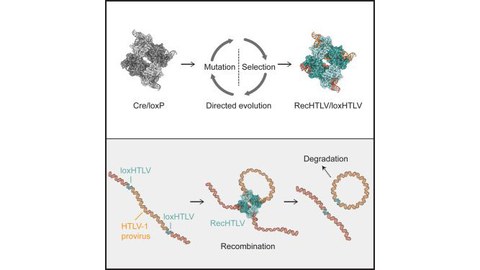Mar 30, 2023
A milestone in the battle against a leukemia trigger
Genetic scissors have succeeded in combating an HIV-related virus in the lab
It triggers aggressive forms of leukemia or an incurable spinal bone marrow disease that leads to paralysis: The HTLV-1 virus is the well-observed but no less insidious sibling of the AIDS-causing pathogen HIV. Both are retroviruses. A group of researchers from TU Dresden, PROVIREX Genome Editing Therapies and Friedrich-Alexander-Universität Erlangen-Nürnberg (FAU) have provided feasible evidence of a potential approach to therapy. They have published their findings in the professional journal Molecular Therapy (doi: 10.1016/j.ymthe.2023.03.014).
About 10 to 20 million people worldwide are infected with the HTLV-1 virus, which is transmitted in over 90 percent of cases via sexual contact or breast milk. The virus is particularly widespread in Japan, Central Australia, South America, parts of Africa and the Middle East. In order to curb the spread of the virus, Japan has issued warnings to infected mothers to reduce the amount of time or completely refrain from nursing their babies. However, babies in poorer regions who have not been breastfed face an increased risk of contracting life-threatening diseases.
Like HIV, this virus is a retrovirus. Moreover, it can cause cancer. After transmission, it covertly incorporates itself into the infected person’s cell DNA. It then typically lies dormant there for decades, passing unnoticed until leading to severe illness in up to 10 percent of carriers, including adult T-cell leukemia/lymphoma, HTVL-1-associated myelopathy and other infectious diseases.
The research group has now found a way to combat the HTLV-1 virus. With special genetic scissors that rely on an enzyme called recombinase – unlike the well-known CRISPR-Cas9 gene editing technique – the group has managed to extract the virus from the DNA of an infected cell in laboratory conditions. In cells in which the virus has not yet fully embedded itself, the designer recombinase (RecHTLV) made infection considerably difficult. But what has succeeded in the lab requires additional comprehensive research before the therapeutic approach can be substantiated. Still, this achievement represents an important step on the path to containing the virus.
“We are confident that the genetic scissors created in the lab can be refined in the course of our research. With regard to HIV, we have already made continual improvements with designer recombinases. Now we are tasked with further adapting RecHTLV to the HTLV-1 virus, which is likewise a retrovirus and thus works similarly,” explains Prof. Frank Buchholz from TU Dresden, who developed this form of genetic scissors.
Even if the research team does not immediately succeed in achieving a complete cure, they stand a good chance of realizing other achievements. “From my point of view, it is crucial to find a way to reduce the viral load in patients. Even if we managed only this, it would mean a substantially lowered risk for patients belonging to the 10 percent of persons affected who experience severe illness,” says PD Dr. Andrea Thoma-Kreß, who is involved in the current research project at FAU’s Institute of Clinical and Molecular Virology. “The risk of transmission via breast milk would also recede if the viral load were decreased.”
Psychological aspects should also be taken into consideration. “Just the knowledge that you have an infection is a severe psychological burden,” says PD Dr. Andrea Thoma-Kreß. “Because patients have the Sword of Damocles hanging over their head for the rest of their life, knowing that illness could break out at any time.” Knowing that a potential therapy exists could work wonders.
The enzyme RecHTLV can already be created under laboratory conditions. It is then transferred to the infected cells by vectors. There, it targets two very specific, identical DNA sequences of the virus that are found at the crossover between virus and human DNA. The recombinase cuts these sequences and reverses the integration. The more cells in which this process can be conducted, the better. “We see the current experiments as successful and promising proof of feasibility,” Thoma-Kreß says. “We are aware that there is still a long way to go, especially because the environment of the virus integration and similar matters must be considered. But these initial achievements motivate us to press forward until we have HTLV-1 under control.”
Contact:
Prof. Frank Buchholz
TU Dresden Faculty of Medicine
University Cancer Center (UCC)
Chair of Medical Systems Biology
Tel.: +49 351 463-40277

